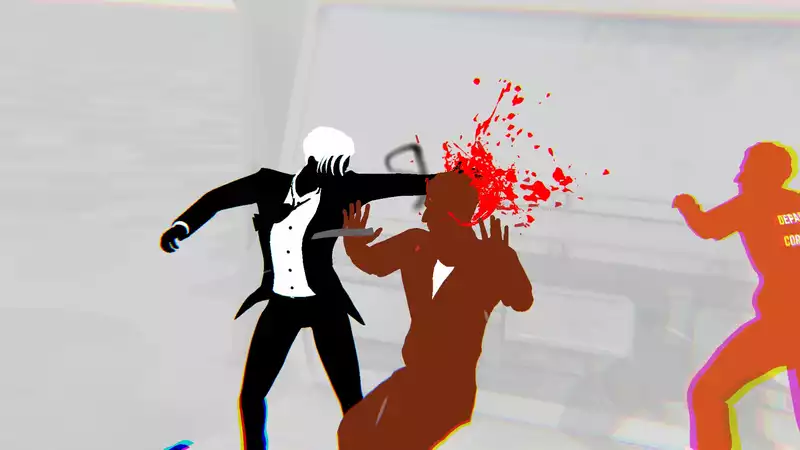While smashing an armed thug's head against a wall and then knocking his buddies out a third-floor window doesn't sound particularly strategic on paper, the small-scale turn-based combat in Fights in Tight Spaces turns even the simplest enemy encounter into a complex turning them into puzzle boxes. While the roguelike trappings may detract from the overall experience, the unforgettable moments when everything comes together and bursts into cinematic violence always shine through.
Stepping into the well-polished shoes of Agent 11, a super spy tasked with destroying an international criminal organization, the game's basic plot is little more than a set dressing to loosely connect the five separate worlds where the action occurs. Divided into a series of semi-procedurally generated levels, each world has you battling through an array of enclosed locations, from dense subway cars to compact office corridors. The Hollywood influence is obvious, and the challenge of recreating iconic movie scenes, such as the bathroom brawl at the beginning of "Casino Royale" or the tea room shootout in "Hard Boiled," is undeniably thrilling.
Despite all being rendered in the same charming minimalist style, the film manages to convey a unique enough aesthetic to make each world stand out impressively. On first play, we are confronted by a prison chef wielding a fearsome kitchen knife before running into a band of bloodthirsty ninjas.
In addition to clear visual differences, later enemies can also be distinguished by their combat abilities. Early on, new arrivals are limited to basic buffs, such as a slight increase in strength and shield recovery. Soon, however, you will be dealing with enemies with complex attack patterns of long-range firearms and the ability to suddenly unleash a counter blow out of turn.
The combat itself is deceptively deep and in my experience required several hours of practice to master. Combat is primarily improvised, and each turn involves juggling a set of selectable cards representing various attacks, dodges, blocks, and moves, as well as limited energy resources. Every card has a specific energy cost that must be met in order to play it, and a tremendous amount of strategy is required to decipher the most efficient way to expend energy in each available hand.
On-screen indicators predict enemy moves to aid your decision-making. This means that you are often faced with a tough choice between avoiding an attack or taking an additional hit on the enemy. Not only does this give every confrontation an exhilarating cat-and-mouse feeling, but it also allows you to take advantage of the enemy's future moves to your advantage. There is nothing more satisfying than watching defenseless soldiers get pushed into an oncoming barrage of artillery fire. I was overjoyed when the meticulous plan to position a group of enemies to punch each other in the face en masse was deployed in a suitably brilliant Rube Goldberg fashion.
At the end of the turn, the opponents are given a chance to take action before six cards are drawn at random from the deck. Once all cards are played or discarded, the deck is reshuffled and the process begins again. This core gameplay loop may seem simple at first glance, but the addition of "momentum," a numerical representation of the flow of combat, increases with each attack and decreases with each block or move. Momentum can be expended separately from energy and is reserved primarily for powerful special moves, functioning like the combos found in traditional fighting games, but with more precise control over how and when the move is performed.
There are also cards that represent several types of injuries, which appear in the deck and gradually decrease in strength if they take too many hits. These cards can only be erased after the battle is over, making frequent use of dodges and blocks essential for survival when facing the hard-hitting foes that appear later in the game. As a result, the combat system in this game is very easy from the start and quite forgiving, especially on lower difficulties.
The emphasis on repeated play is also effective, as new starting decks are gradually unlocked and you can even build your own decks, giving you a solid sense of progression. The same cannot be said for a handful of the game's other roguelike elements, however. In particular, the bonus objectives for each mission, which earn currency for completing them, become far too difficult as the game progresses.
Challenges like completing increasingly tricky levels in just a few turns sometimes seemed completely impossible, and my limited success always depended more on lottery luck than actual skill. To make matters worse, money is a critical factor in winning on the higher difficulties, as it is used for everything from upgrading cards on the fly to replenishing your strength between fights. We quickly learned that the most effective strategy was to focus only on easy optional objectives in the early stages to ensure we had enough money for upgrades when the challenge became more difficult. While by no means a deal-breaker, this slightly haphazard implementation of the in-game economy stands out amongst the very polished combat and clean visuals.
.

Comments